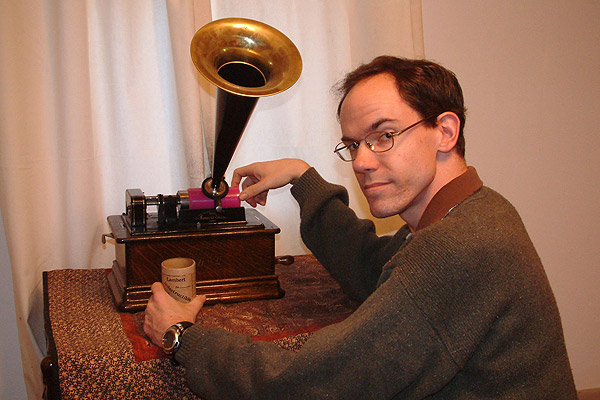
Via Alison Cuddy: Patrick Feaster, a sound-recording historian at Indiana University, has pushed back the history of sound recording back even further than his previous discovery. Feaster stumbled across a magazine printing of a late-1800s recording by self-educated German immigrant Emile Berliner, whose work can be found in the development of the telephone, acoustic tiles, and helicopters. (Appropriate to the holiday, Berliner was inspired by a centennial-year demonstration by Alexander Graham Bell.) Feaster actually scanned the print of the recording, which preserved its grooves, and turned it back into sound:
Feaster had created sound from such images before, a seemingly impossible task accomplished by scanning the record-shaped image, unwinding — or "de-spiraling" — it and linking the resulting sections to create a linear file that looks much like a modern-day audio clip, then running it through specialized software to create a sound file.
Perhaps you're old enough to remember flexi-discs being inserted into magazines and books—I'm just old enough to have a copy of "U Stink (But I Love You) / I'm a Boinger" from Billy and the Boingers Bootleg. It's sort of like that, only much, much more difficult to play. In this video, you can get a sense of the process:
Feaster got started early, as he describes in his IU dissertation (PDF):
I started collecting 78 rpm records as a grade-schooler, along with a variety of other old things: coins, stamps, newspapers, books, beer cans; in fact, I used to joke that I “collected collections.” My family spent a lot of weekends at estate sales, swap meets, flea markets, and antique shops, seeking out disheveled furniture to refinish and parts for a 1930 Model A Ford truck my father had begun to restore as a bicentennial project. In retrospect, I suppose my collections gave me something to do during these outings that was also feasible on a dollar-a-week allowance. Most of these collections fell by the wayside in high school, but a few years later, now with a master’s degree in history, I happened across a stack of 78 rpm records—cheap—at a junk store in Martinsville, Indiana, and picked them up for old time’s sake. This find rekindled my interest, and soon I was combing the Internet for information about “pioneer recording artists” and record labels, bidding on hard-to-find items in vintage record auctions, and branching out into wax cylinders and other more challenging formats.
He's not the only crate digger to come out of IU; the owners of the great Urbana-based label Archeophone developed their interest in early wax-cylinder music by traveling the same Indiana backroads to find early examples of American popular music, and built a self-sustaining label out of it. They're like the Numero Group, but resurrecting stuff many decades older:
[Richard] Martin, like a lot of people in their 30s (he's 39), wasn't as fanatical about music as he had been growing up. But after he finished his qualifying exam at Indiana University for a doctorate in American and British 20th-century literature, he was "bored to tears," and collecting old music filled a gap. "I spent lots of time in old barns and falling-down houses all over Indiana and Missouri," he says. "You'd find out that there were people who had caches of these things that hadn't been touched in years, and so you drive 20 miles into the country."
It makes sense, in a way, that Indiana would be home to such early vinyl obsessives. The first great indie label, Gennett Records, originated in Richmond, Indiana; without the budget of Victor and Columbia, Gennett cast its net wide, from exercise recordings to William Jennings Bryan speeches. In that net fell an unimaginable cast of future legends:
The artists Gennett recorded in the ‘20s were unfamiliar at the time, but read like a jazz hall of fame today: Duke Ellington, Jelly Roll Morton, the King Oliver band – which included a bottle green Louis Armstrong, Bix Beiderbecke, the New Orleans Rhythm Kings and Hoagy Carmichael. Gennett also recorded bluesmen Big Bill Broonzy, Charlie Patton, Blind Lemon Jefferson and future country legend Gene Autry and other hillbilly pioneers Fiddlin’ Doc Roberts, Vernon Dalhart and Bradley Kincaid.
If eastern Indiana seems like a curious place for the great geniuses of jazz to cut records, that's not the half of it. Indiana had the highest Klan membership in the country as Gennett was at its peak, and Gennett did contract pressings for the KKK label (the labels themselves look as creepy as you'd expect). Fortunately and unsurprisingly, the Klan's musical stars were not nearly the talents that Ellington and Armstrong were:
The main item on the Klan's agenda was to stop the massive immigration that had been going on since the Irish potato famine of the 1840s…. Most of the music is filched from well-known Christian hymns (i.e., "Onward Valiant Klansmen" = "Onward Christian Soldiers" etc.), though some are originals. There's even a comic element in songs like "The Stuttering Klansman." My personal favorite amongst the ones I've heard is "Why I Am a Klansman" (KKK 75003). The tune is jaunty and jolly, and the record is something of a production with a string section, vocal quartet and soloist. The whole thing is catchy and perverse enough to be the granddaddy of "Springtime For Hitler."
"Mystic City" (attributed to "100% Americans with Orchestral Accompaniment") does, indeed, sound like third-rate Sousa mangled into musical theater, with more than a passing resemblance to Monty Python's Spam song and MST3K's Gamera song. It's the old, weird, racist America distilled to a point: race records and racist records, sharing a studio.
Photograph: Indiana University


